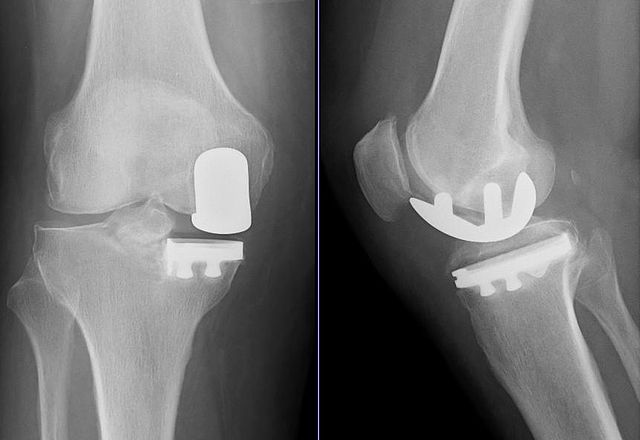Chronic knee pain is a complaint that is often heard with wear-and-tear or trauma to the joints in the knee. Made even worse by injury or infection, pain can develop when the cartilage in the knee meant to cushion your bones, becomes damaged enough for the bones to rub together.
With enough repetitive motion and stress put on the area, osteoarthritis often sets in years later resulting in severe pain, stiffness and swelling in the area.
Arthritis is a painful and debilitating condition affecting 20 per cent of Canadians that can make it difficult to move the affected joint. There are two main kinds: osteoarthritis and rheumatoid arthritis.
While rheumatoid arthritis is caused by an autoimmune disorder, osteoarthritis is caused by the repeated stress and/or injury to an area like the knee. Age is also a factor that can exacerbate the situation.
Still, the most common reason for a knee replacement is the onset of arthritis in the area and the debilitating impact on mobility. This is typically when the patient presents themself to the doctor with the symptoms.
A knee replacement is often recommended to fix the problem and eliminate the symptoms once things get to the point where the discomfort, stiffness, pain, and swelling is too much to bear.
Learn how to protect your bones against osteoarthritis. Read The Health Insider’s article: Building Strong Foundations.
One Patient’s Personal Experience
Though not caused by arthritis, Marcia E. has dealt with knee pain for years. Having played tennis for a good part of her life, the repetitive motion and strain on her knees resulted in both pain and swelling. In 2023, the time came to replace her first knee.
Marcia’s relationship with her doctor along with her time flexibility came in handy to snag a coveted spot, for which she otherwise would have had many more months. She made it a point to remind both the doctor and his assistant that she would be willing to come in for the procedure on short notice, should there be a cancellation.
In the end, Marcia had both knees replaced, though not at the same time. In both cases, she waited no longer than two months. Flexibility and resourcefulness counts when waiting for much-needed surgery.
The Current State of Affairs for Knee Replacement Surgery
Over 140,000 knee replacement surgeries are performed each year in Canada, making it the second most popular inpatient surgery in the country.
While the goal for most hospitals in Canada is to have a presenting patient undergo knee replacement surgery within six months of their initial consultation, most hospitals are beyond backed up, though some provinces more than others.
Only 60 per cent of required knee replacements in 2023 were completed within six months; many patients have and will continue to wait a full year or more before finally checking in for their hospital stay.
Even though the process can be a hassle, it’s important to consider what could happen if you don’t get a knee replacement when needed.
A CDC study found consistent knee pain, caused by osteoarthritis or by itself, can raise your risk of mortality, particularly if you’re obese. Though mortality is raised for all individuals, younger people seem to be most at risk.
The study continues that this can be explained because there is the expectation of “long-term psychological distress and disability.” This can lead to depression, reduced physical activity (potentially being wheelchair-bound depending on the extent of pain and deformity), and weight gain, which in turn can result in more pain.
While some studies differ in opinion on whether osteoarthritis increases the risk of all-cause mortality, they all tend to agree that at the very least, osteoarthritis (typically with knee pain) can raise your risk of developing cardiovascular disease and diabetes.
Curious about how cardiovascular disease affects women? Read The Health Insider’s article: Unmasking Gender Bias: The Crisis of Heart Disease in Women.
Types of Knee Replacements
Depending on the severity and location of the issue, patients will either receive a full or partial knee replacement. The surgery should rid you of pain and make it easier to move the joint. Both replacements have a long lifespan and should last 10-15 years or more.
A total knee replacement is exactly what you’d think – the surgeon removes the entire system (ligaments, tendons, remaining cartilage, bone, etc.) and replaces it with an artificial knee. This is the most common type of knee replacement surgery, especially considering nearly six million Canadians suffer from arthritis.
How does it feel once you’ve had the surgery? Both of Marcia’s surgeries were total knee replacements. “It doesn’t feel like it’s really yours, but it feels really strong… you’re bionic,” she says.
A partial knee replacement is more common in younger people with trauma injuries such as a torn ACL. With this surgery, you keep most of your original knee and only replace the damaged parts.

Partial replacements offer a more natural feel and movement because you’re able to retain most of your joint. With less to replace, there are also fewer potential complications.
Complications
Johns Hopkins Medicine lists potential complications of knee replacement surgery:
- Bleeding
- Infection
- Blood clots in the legs or lungs
- Loosening or wearing out of the prosthesis
- Fracture
- Continued pain or stiffness
Option One: Public Healthcare
The most cost effective option, publicly funded knee replacement surgery will still have out of pocket costs, but nowhere near the price of a private clinic.
A singular knee replacement performed as an inpatient surgery in a Canadian hospital will cost approximately $10,000 (not including rehabilitation) but insurance can cover most of the total.
Medications and other needs post-surgery will not be covered by provincial health insurance. Check with your personal insurer for details.
For provincial insurance coverage, you must prove that the surgery is medically necessary through the presence of persistent pain even when resting or deformity caused by arthritis.
Hospitals are limited in the implants they can offer patients by the stock they have available. Hospitals may not carry the newest models of artificial knee joints on the market or have the most recent technology.
The minimum wait is generally six months, but expect to wait longer as the overwhelmed public health system continues to fall behind.
Option Two: Private Clinics
The biggest selling point of a private clinic in Canada is the expedited care. Marcia’s two month wait is not the norm for the public system. Private clinics in Canada have far more control over their schedules and patient load meaning there is little to no wait time depending on the location.
The procedure is costly though. A singular knee replacement can cost between $20,000-$30,000. While provincial insurance won’t cover the costs, personal/professional insurance may cover a portion.
This figure doesn’t include the cost of physical therapy afterwards, which is necessary for a full recovery.
Post-op, patients should almost fully recover from surgery in six months. Quality rehabilitation, especially offered by private clinics, may shorten the healing time.
Recovering From a Knee Replacement
Though a common and safe procedure, it is not easy sailing post-op. Your doctor will provide you with a prescription for an opioid like morphine to help manage the pain, but not everyone takes well to the strong drugs.
Another option for pain relief is over the counter medications, which may not be strong enough to provide much relief. Marcia said she needs something in between in strength, but has to settle for what’s available.
“I could never do [both knees] at once, it’s just too painful,” Marcia said. She said it’s essential to find a good caregiver (family member, friend or professional PSW) for the first week post surgery as it’ll be difficult or impossible to do much on your own.
In her experience, after four or five weeks, you can dial down the medications and can finally regain a sense of independence as you’re able to move better on your own.
For a smoother recovery, Marcia recommends being organized before going in for surgery. “Organize your closet so it’s all in one place,” she said.
The bathroom should be organized too, with everything you’ll need within easy reach on the counter if possible, “so that the people who are helping you don’t have to look in every drawer and every cupboard.”
Picking an Knee Replacement Implant
You and your surgeon will talk about the best options for your needs. There are many companies and styles of replacements to choose from, your surgeon will guide you through the choices.
Health Insider Tip: Ask your surgeon about the pros and cons of using older knee replacements instead of newer models. While not practical for everyone, older models can come with fewer unforeseen issues because they’ve been in circulation for longer.
If you have any concerns about your chosen device, you can check for recalls and safety alerts here: https://medicaldevices.icij.org/.
Everyone deserves to move without pain, but costs can get in the way. The public healthcare system is a viable option for replacement surgery, but as it continues to lag behind, private clinics are filling the gap.
For those who can afford the steep price, private healthcare clinics are providing essential services, quality care, and are reducing the burden on the public system.
~ Read more from The Health Insider ~
- Leftovers Safety: Store & Reheat Like a ProLearn how to store and reheat holiday leftovers safely. From the “Two-Hour Rule” to freezing tips, keep your Canadian kitchen healthy this season.
- Guilt-Free Indulgence for the Holidays. This is How it’s Done.Enjoy every plate this season! Prep your gut with our low-effort tips: boost hydration, sip digestive tea, and avoid the post-feast crash.
- Health Canada Authorizes TNKase for Treatment of Adult StrokeHealth Canada officially authorizes TNKase for treating acute ischemic stroke in adults. This pivotal approval introduces a faster, 5-second injection to emergency rooms nationwide.
- Generic Ozempic: Canada to See Significant Price DropsStruggling with high medication costs? Generic Ozempic is coming to Canada in 2026. Learn how prices could drop from $400 to around $100.
- Affordable Dental Care is Here. This is where to find it.Don’t let cost stop you! THI breaks down the Canadian Dental Care Plan (CDCP) and shows you where to find discounted, supervised care near you.
- Wegovy Authorized as Canada’s First Liver Disease DrugNo more “watchful waiting.” Health Canada’s approval of Wegovy gives MASH patients their first tangible medical option to fight liver fibrosis.
The information provided on TheHealthInsider.ca is for educational purposes only and does not substitute for professional medical advice. TheHealthInsider.ca advises consulting a medical professional or healthcare provider when seeking medical advice, diagnoses, or treatment. To read about our editorial review process click here.
















